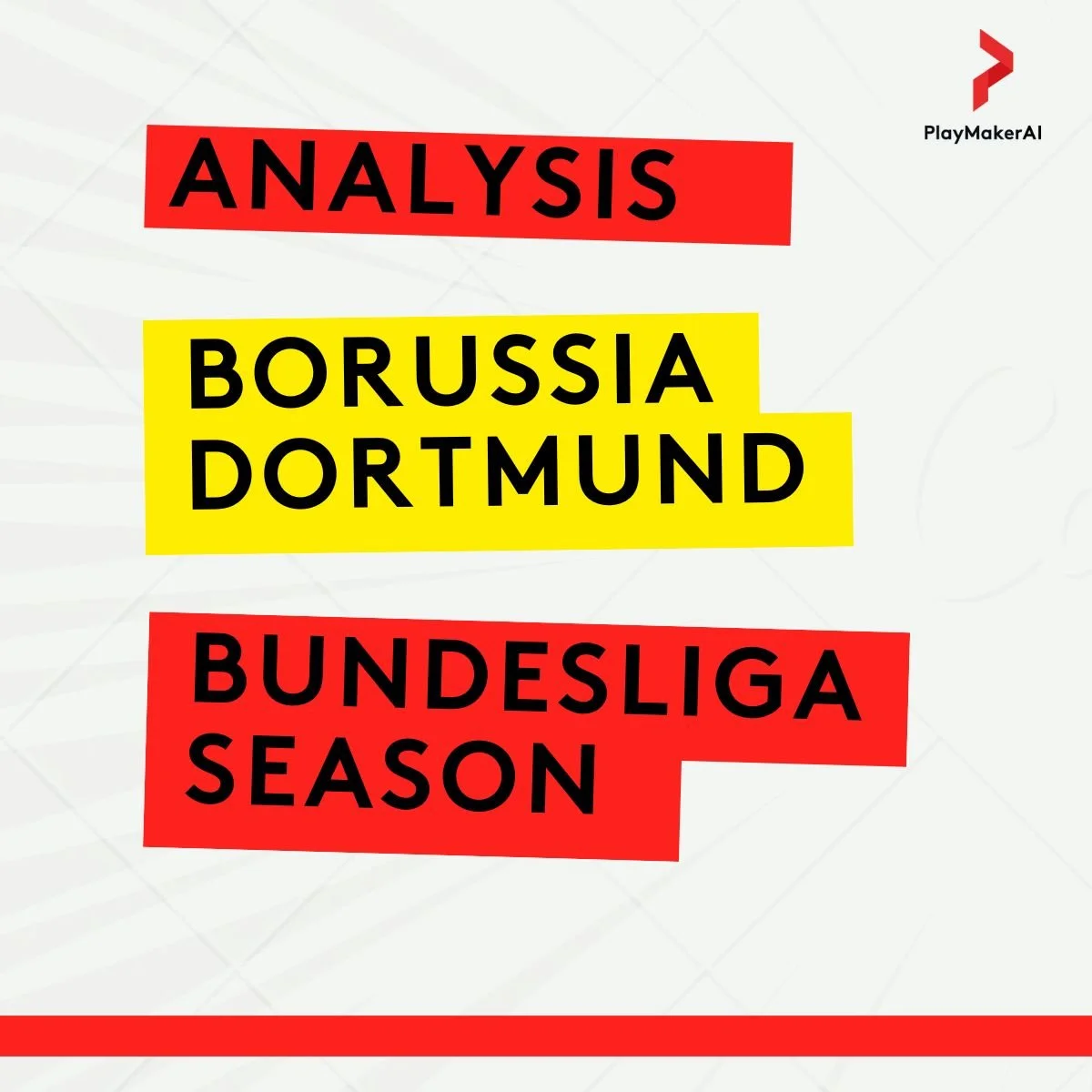Borussia Dortmund 2024/25 Bundesliga Season Analysis
In football, some seasons can hinge on fine margins - a deflection, a moment of brilliance, a brief shift in formation. And then there are seasons that divide cleanly in two, where the same players wear the same shirt, but the football they produce tells two entirely different stories.
Borussia Dortmund’s 2024/25 campaign was not a slow evolution, but a stark divide. A team adrift under phase one of the season and reborn under another.
During the fall, Dortmund played like a well-drawn blueprint. The possession was calm, the build-up was controlled, and the structure was clear. But just like a plan on paper, it often lacked the final touches - the spark, the finish, the goal.
After Niko Kovač's arrival during spring, the club’s outlook changed.
Let’s dive in.
Spring is coming
To understand the extent of Dortmund’s transformation, we don’t need to look far. The table - often accused of lying - tells the truth here with striking clarity.
After 20 games, Dortmund sat 11th in the Bundesliga. They were conceding nearly 1.9 goals per game, scoring just 1.74. The team had collected 26 points. According to PlaymakerAI’s Expected Points (xP) model, an AI-driven metric that estimates how many points a team would have earned on average based on performance and underlying data, Dortmund could arguably have come away with a few more. Their xP tally stood at 30.7, suggesting they might have ranked slightly higher in the table.
Still, the pattern was clear: teams that concede more than they score tend to find themselves in the bottom half of the table
That’s not a mystery. That’s logical.
Over the next 15 games, Dortmund climbed to 2nd in the form table. They averaged 2.33 goals per game, cut their conceded goals per game down to 1.33, and banked 28 points with an Expected Points (xP) of 29.6, proving it was not luck. In fact, that xP total was the highest in the league over that 15-game stretch meaning that, according to PlaymakerAI’s advanced models, Dortmund delivered the strongest underlying performances of any team during that period.
And as can be expected, when you start scoring more than you concede per game, football gets a lot more enjoyable.
That’s not advanced metrics. That’s table gravity doing its job.
The Half We Don’t Talk About
But to understand the rise, we need to sit with the fall.
Let’s look at the different phases through the eye of a spider chart:
At first glance, the fall chart reflects a clear tactical ambition: control through possession. The plan was to dominate the game by dictating the ball. But once possession was secured - then what?
That’s where the execution fell flat.
There was little end product to show for all the control. Crosses, passes into the box, Expected Threat, Expected Goals - all underwhelming. The attacking patterns lacked penetration, and the data confirms it.
Fast-forward to spring, and it’s a completely different story - and a different statement.
During spring, threat creation spikes, Expected Goals climb, shot volume increases, and their presence in the final third becomes undeniable. The team begins winning the ball high, pushing numbers into dangerous areas, and delivering more crosses and box entries with conviction.
So, what did they give up in return?
A slight drop in possession metrics. But this wasn’t a loss - it was a trade, and a calculated one. The ball may have been shared more, but now every touch had intent.
Lets deep dive into Expected threat:
What is Expected Threat (xT)?
It’s a way of measuring how dangerous a team is when they attack - not just when they shoot, but throughout the whole build-up. Unlike Expected Goals (xG), which only kicks in when a shot is taken, xT looks at every action during a possession: passes, dribbles, and movements that move the ball into more dangerous areas. It tells us how much a team is threatening the opponent’s goal, even if the attack doesn’t end in a shot.
Think of it as a way to measure how often a team gets into those dangerous pockets - the final third, the box, or other high-impact areas - where goals tend to come from.
Transitions
The fall chart shows it plainly: not much happened after Dortmund won the ball. In fact, they were performing below league average in creating chances within the first 8 and 15 seconds after a ball recovery - two key indicators of effective transitions.
In contrast, the spring data reveals a clear shift. Dortmund moved with more urgency and purpose after winning the ball, leading to more frequent and more dangerous chances in those early moments. The improvement in both Expected Goals within 15 seconds and Expected Goals within 8 seconds points to a team playing faster, with a sharper instinct to attack.
Another supporting metric is counter pressure - the ability to win the ball back on offensive half after losing it in the final third. In the spring, this number ticks upward as well, signaling a more aggressive pressing approach. And the logic fits:
When you win the ball higher up the pitch, the opponent is off balance - disorganized, vulnerable and you are closer to the opponents goal. That’s when real chances appear, and the expected goals rise accordingly.
Put simply: better pressure, faster transitions, and smarter positioning led to more goalscoring opportunities - and more wins.
Looking at the Expected Goals Against (xGA) metrics 15 and 8 seconds after a ball loss we can see a shift in being exposed from the fall to the spring. Due to these ”negative” metrics, the value in the spider chart is inverted - the further out it is, the better percentile they rank (i.e. the lower xGA, the more expanded in the spider chart).
The Expected Goals Against after 8 seconds is much better during spring than it is during the fall.
The Rise Beyond the Wall
In Dortmund, football isn’t played in silence. It echoes off the steep stands of the Westfalenstadion, through the roars of the Yellow Wall. And when the team began to rise again, it did so with its people - not just beyond the wall, but because of it.
What emerged in the spring was something closer to the club’s true identity: high tempo, vertical threat, and collective conviction. The shape of the football changed. The rhythm changed. And so did the direction of the season.
So let’s look at where Dortmund truly stands out in the league during spring. And speaking of the Yellow Wall. During the spring, something fascinating happened: they became the Bundesliga’s most dangerous team away from home.
Looking at the data, Dortmund ranked first in Expected Goals per game on the road:
Earlier we also mentioned the transition game. Looking into the data of Expected Goals 8 seconds after a ball win we can also see that Dortmund top the league during spring. In fact, Dortmund is even the best team of all European top 5 league teams in xG 8 seconds after 8 ball win.
Game states
Looking at their performance in different game states (when they were leading, at a draw or behind) we can see accentuations of styles.
An increase in counter attacking whilst in the lead is very reasonable as we expect Dortmund's defensive line to drop while the opponent is doing the opposite.
A less direct and safe style of play is what we see from Dortmund in the lead albeit with a noticeable exception of throw in control, a metric that counts possession 5s after the throw in.
On the other end of the spectrum, when behind, we see a more direct play with more long balls and more action in the opponents box. A higher line with more applied pressure results in more balls won in the offensive third that are converted to a significantly higher xG average.
However, it’s worth noting that this increase is not seen as much in the Expected Threat (xT), a result of a shot oriented attack leading to a higher conversion rate of xT to xG.
Another context to this is that our analysis shows that Borussia Dortmund was the team that played the most minutes while leading during the spring, starting in February.
True Dortmund
What emerged in the second half of the season wasn’t just an improvement in performance - it was a return to something more familiar, more fundamental. The numbers rose, yes: more goals, more threat, fewer goals conceded. But more importantly, the feeling returned. The football looked like Dortmund again.
This was a side that pressed with intent, attacked with directness, and carried energy into every transition. The hesitation of the fall gave way to purpose. Control no longer meant circling the pitch in search of openings - it meant seizing the ball, striking fast, and forcing the opponent to adapt.
In data, we see the shift. In matches, we saw conviction. The second half wasn’t just better. It was bolder. It was braver. It was Dortmund - true Dortmund.
Note: This analysis was made with one game left of the season.
Would you like a season analysis breakdown for your club?











